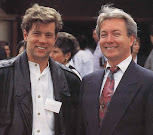The story of Korihor resembles many scenes in nineteenth-century America and Britain. Alma and Korihor are not arguing because they are so unlike each other. They are, in fact, arguing from a shared set of references.
In fact, Korihor argues positions already taken by The Book of Mormon: “a child is not guilty because of its parents"; priests bind “yokes” on others.
So why is Korihor a problem?
He is an atheist. The trouble isn’t his positions but the deductions he forms from his positions.
Atheism in Context
One important aspect of any religion is that what may appear uniform to outsiders and even to future adherents does not appear that way to insiders and believers at the time. The early Christian world split in two over the question of whether Christ was a spiritual manifestation (equal) of God or a son (non-equal) of God. Likewise, Buddhists almost immediately took up different explanations of "rebirth" at the beginnings of Buddhism--what rebirth entails, how it comes about.The differences may matter. The arguments, however, often appear entirely incomprehensible to everyone else.
Deists in eighteenth to nineteenth-century America are a good example of the gap between outsiders’ and insiders’ perceptions.Deists in nineteenth-century America now appear as somewhat bland, honorable, club-attending, gentle Christians. The "Founding Fathers" were largely deists—isn't that nice?
To early Americans, deists were radicals, and it was generally recognized that while not all deists were atheists, many atheists were nominally deists (taking into account that "atheism" has had different definitions in different time periods). No public, publishing colonial writer was obviously atheistic. Thomas Paine, for instance, called what he was arguing for "deism," and he was criticized for it.Like with most religions of the era, deism rested on “evidential” reasoning—the idea that the natural world and rational argument could prove philosophical and, if necessary, religious truths. The idea influenced generations of believers, from literalists using the natural world and the Bible to prove the equivalent of Creationism to near-atheists using the natural world and Bible studies (coming out of Germany) to prove the non-existence of miracles.
Consequently, nineteenth-century believers would have comprehended Alma's alarm at Korihor’s contention, “How do ye know of their surety? Behold, ye cannot know of things which ye do not see; therefore ye cannot know that there shall be a Christ” (30:15).Korihor also proposes antinomian arguments (no moral law exists as a norm), which arguments have haunted religious and philosophical thought since the beginning of time. Jain Buddhists, for example, were concerned that rebirth of a person without a definite “I” soul would result in nihilistic or dismissive attitudes towards current bad behavior.In nineteenth-century America, everybody was accusing everybody else of antinomian arguments: the Calvinists got accused of it for proposing that God has already determined salvation—therefore, moral goodness of the individual didn’t matter. The Universalists got accused of it for saying everybody would be saved—therefore, individual improvement didn’t matter.
Evidentiary Religion
Both Alma and Korihor argue from the perspective of evidentiary religion, a perspective nineteenth-century readers would have recognized.
On the one hand in the nineteenth century was the belief that all theological knowledge rested exclusively within the scriptures. On the other was respect for tradition, the analysis and insights of Church theologians over the years. Both sides argued that theology was backed up by external evidence (science/nature) and had to make rational sense (George MacDonald presents a variation of this approach when he argues that any interpretation of doctrine that violates commonsense is probably, you know, wrong; he also refuses to treat the Bible as the final stop). In the meantime, scholars were arguing, "Hey, maybe that interpretation isn't contextually what Paul meant in the first place."
Congregations split between the revivalist focus on individual testimony and those who thought such a focus was self-indulgent. Nobody was going so far as to say, “God is telling me to create new doctrine" (only the Millennialists). Rather, debates circled around a particular scripture’s original intent followed by evidence for that intent.When Alma states, “[B]ehold, I have all things as a testimony that these things are true," nineteenth-century readers would have recognized the statement as underscoring evidentiary proof and as opening the door to revelation beyond the scriptures.
They also would have recognized his and Korihor's use of rational, point-by-point arguments.
The scriptures are laid before thee, yea, and all things denote there is a God; yea, even the earth, and all things that are upon the face of it, yea, and its motion, yea, and also all the planets which move in their regular form do witness that there is a Supreme Creator. (44)
What All These Issues Mean to Nineteenth-century Readers
The chapters involve remarkably nuanced arguments but ones that early nineteenth-century readers would have related to—this is the tail end of the era in which Congregationalists were still trying to square predestination with free will and works. Many arguments between Protestant sects and, for that matter, between various Calvinists rested on points of doctrine.
And, as always, there were lots and lots of in-between believers: those who embraced many of the same ideas as Calvinists and Universalists and even Deists while refuting others. That is, they had no trouble embracing grace while admitting, “Yeah, people shouldn’t be jerks.” Nineteenth-century readers would have easily balanced the “same” elements of Alma and Korihor’s arguments against their differences.
It is a truth of religious argument that the arguers are usually speaking the same language. They often understand each other better than outsiders understand them.
In sum, Korihor isn't at fault for arguing. He is at fault for being reductionist and dreary.
They didn’t want to discard rationality and evidence from the
natural world—but why should that mean getting rid of the unseen,
unknowable, and unprovable?
Since quantum mechanics hadn’t yet shown up in the sciences, they had a point.







